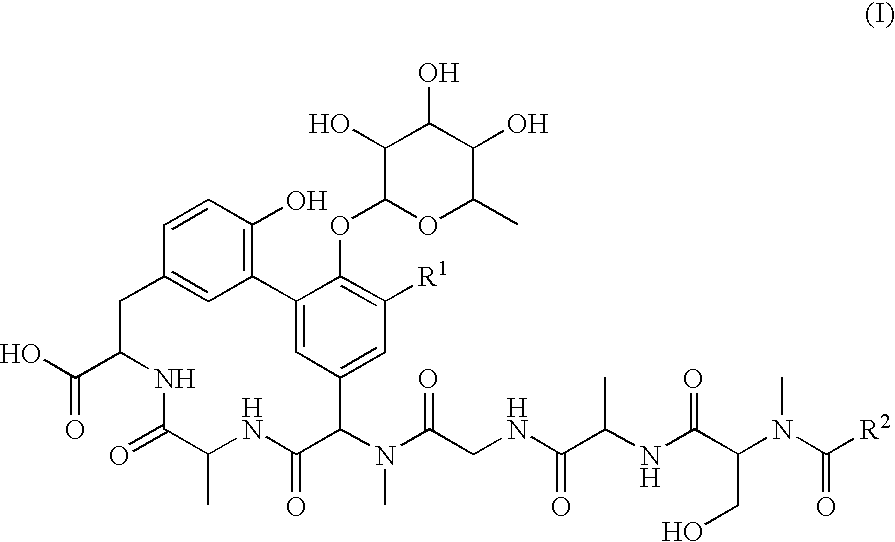Lipoglycopeptide antibiotics
a technology of lipoglycopeptide and antibiotic, applied in the field of pharmaceutical chemistry, can solve the problems of increasing increasing the cross-resistance of existing and emerging bacterial resistance to many of the current antibiotics, and increasing the death rate of bacterial infections
- Summary
- Abstract
- Description
- Claims
- Application Information
AI Technical Summary
Problems solved by technology
Method used
Image
Examples
example 1
Preparation of Inocula
[0089]Aliquots of actinomycete culture ATCC No. PTA-3545, ATCC No. PTA-3546, and ATCC No. PTA-3547, stored in the vapor phase of liquid nitrogen, are thawed and used to inoculate 20 ml portions of vegetative medium. The vegetative medium is composed of (in g / l) tryptic soy broth (BBL Cat. # 211771) (30), yeast extract (DIFCO Cat. # 212730) (3), MgSO4.7H2O (2), glucose (5), and maltose (4). Approximately 100 μls of thawed cells are used to inoculate a ml portion of the vegetative medium contained in 100 ml plastic bottles fitted with a vented membrane cap (Performance Systematix, Inc., Caledonia, Mich., cat # MRP28-400). The bottles are then incubated with shaking at 165 rpm at 30° C., for 72 hr. At the end of the incubation period, an aliquot of each vegetative culture is streaked on TSB (Trypticase Soy Broth) agar plates to ensure that the culture is axenic.
example 2
Production of Novel Lipoglycopeptides 1-8
[0090]2 ml of axenic vegetative culture as described in Example 1 are inoculated into 800 ml of fermentation medium contained in 2.5 liter non-baffled plastic conical flasks (Scandia Plastics, Sheboygan, Wis.) covered with two layers of Bio-Shield paper (Baxter Healthcare Corp., Deerfield, Ill., cat. # 4008). The fermentation medium is composed of (per liter): MOPS (3-[N-morpholino]propane-sulfonic acid)-Na salt, pH 7.0 (23.1 g), CaCO3 (g), CaCl2·2H2O (0.228 g), MgSO4·7H2O (1 g), 1000× trace metal mix (1 ml), 100× vitamin mix (10 ml), glucose (9 g), potato starch (0.5 g), (NH4)2SO4 (0.1 g), and Pharmamedia (Traders Protein, Division of Archer Daniels Midland Company, Memphis, Tenn.) (9 g). The 100× trace metal mix is composed of (g / l): Fe-EDTA (3.5), CuSO4·5H2O (0.5), Na2MoO4·2H2O (0.5), FeSO4·7H2O (0.5), ZnSO4·7H2O (0.4), MnCl2·4H2O (0.02), CoCl2·6H2O (0.01), NiCl2·6H2O (0.01), and H3BO3 (0.015). The 1000× vitamin stock is composed of (g / l):...
example 3
Isolation of Lipoglycopeptides 1-8
[0091]The whole broth (40 flasks×800 ml) of Example 2 is centrifuged using a Beckman J6B centrifuge JS-5.2 rotor at 2100 rpm for 15 min. The supernatant is removed from the cell pellet and is discarded. The pellet is extracted twice, each time with liters of methanol. The combined methanol extracts (liters) are concentrated in a rotary evaporator to approximately 500 ml (mostly aqueous) and partitioned with 500 ml of reagent grade methanol and 1 liter of reagent grade ethyl acetate. The ethyl acetate upper layer is removed and the remaining solution is further partitioned with 1 liter of reagent grade ethyl acetate. The two ethyl acetate upper layers are combined and evaporated in vacuo to a residue (49 g). The residue is suspended in 300 ml of 3:1 (v / v) methanol-water, and the insoluble materials are removed using a 0.2 micron membrane filter (Corning® Cat. # 430773). The clear filtrate is then diluted with approximately 600 ml of deionized water t...
PUM
| Property | Measurement | Unit |
|---|---|---|
| flow rate | aaaaa | aaaaa |
| flow rate | aaaaa | aaaaa |
| flow rate | aaaaa | aaaaa |
Abstract
Description
Claims
Application Information
 Login to View More
Login to View More - R&D
- Intellectual Property
- Life Sciences
- Materials
- Tech Scout
- Unparalleled Data Quality
- Higher Quality Content
- 60% Fewer Hallucinations
Browse by: Latest US Patents, China's latest patents, Technical Efficacy Thesaurus, Application Domain, Technology Topic, Popular Technical Reports.
© 2025 PatSnap. All rights reserved.Legal|Privacy policy|Modern Slavery Act Transparency Statement|Sitemap|About US| Contact US: help@patsnap.com



